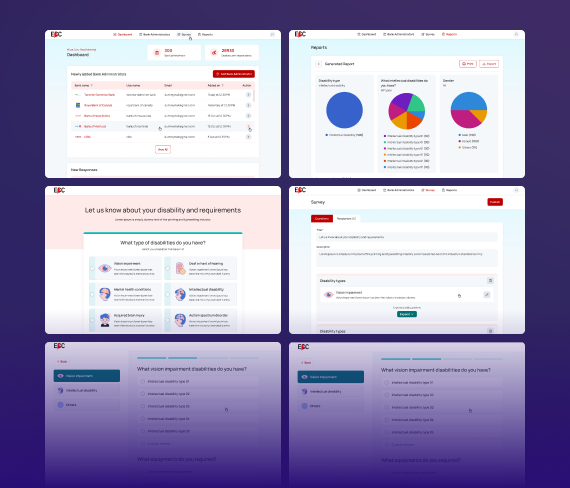

Case Study: Streamlining the Disability Accommodation Process Through a Multi-Tier Web Application
Problem
In recent years, there has been a growing demand for a more inclusive and streamlined process for individuals with disabilities to request and receive the necessary accommodations. Many organizations, including financial institutions, have struggled to efficiently manage the complex workflow of gathering disability-related information and ensuring the appropriate accommodations are provided. The traditional methods have often led to inefficiencies, miscommunications, and a lack of centralized oversight.
To address this, a web-based application needed to be developed for various stakeholders (end users, bank administrators, and super administrators) to manage disability forms, requests, and accommodations more effectively. The goal was to create a centralized system where all involved parties could interact, manage, and track the process smoothly.
Challenges
Complex Workflow and Multiple Stakeholders:
The application needed to handle multiple user types: end users (those filling out disability forms), bank administrators, and super administrators. Each user group had unique requirements and responsibilities, leading to a complex system design. Ensuring that these journeys were distinct yet interconnected was a significant challenge.
Customizability and Scalability:
The application needed to offer flexibility for users to input custom disabilities and accommodations, while also allowing administrators to customize questions and responses for different banks. Building a system capable of scaling with various user inputs while maintaining data integrity was essential.
Data Reporting and Analysis:
The platform also needed to include robust reporting tools that would allow super administrators and bank admins to generate and export reports based on disability types, accommodations, and user demographics, such as gender. Ensuring that data could be effectively visualized and exported in formats like PDFs required careful planning.
Secure and Efficient Authentication:
With sensitive personal information being handled, a secure login system for all user types (super admins, bank admins, bank users) was critical. The challenge was to ensure data privacy while providing an intuitive, efficient user experience.
Solution
To address these challenges, a multi-tier web application was developed with the following features:
User-Centric Disability Form Submission:
End users can choose one or multiple disability categories, select specific disabilities, and request accommodations. For custom disabilities, users can input their information manually, providing a highly flexible form that caters to a wide range of user needs. For multiple disabilities, users must repeat the form process, ensuring that each disability is fully addressed.
Streamlined Admin and Bank Admin Dashboards:
Both super admins and bank admins have dedicated dashboards that give them an overview of respondents, end users, and bank users. Super admins can view the total number of bank admins, respondents, and even have control over managing survey questions. Bank admins can manage bank-specific questions and view recent responses from both end users and HR-generated links.
Customizable Surveys and Reporting Tools:
Super admins and bank admins have the ability to create, modify, and delete survey questions regarding specific disabilities and accommodations. Additionally, robust reporting features allow admins to generate detailed reports in both pie-chart and tabular formats. Data can be exported as PDFs, and the ability to compare data across respondents adds significant analytical power.
Secure Login and Authentication:
A secure login system ensures that only authorized users can access specific features of the application. Super admins, bank admins, and bank users all have tailored access levels, ensuring sensitive data is protected while giving users the necessary tools to perform their tasks.
Conclusion
The web-based application successfully addressed the core problem of managing and accommodating disabilities for individuals in a secure and efficient manner. By creating a flexible, user-friendly system that catered to multiple stakeholders, the application streamlined the entire process. Super admins and bank admins now have full visibility into the system’s usage and can make data-driven decisions through the reporting tools.
This case study highlights the importance of a well-structured, scalable application in meeting the needs of a complex, multi-user process. The result was a more inclusive, efficient system that ensures individuals with disabilities receive the accommodations they need, while administrators have the tools to manage and oversee the process effectively.
